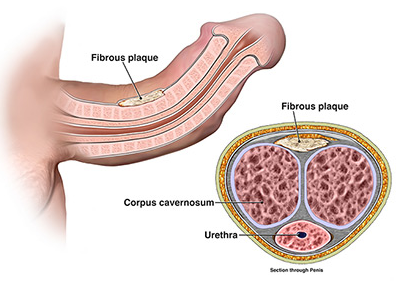Back
Male Infertility Part 3: Peyronie's Disease
By Pelvic Health Physical Therapy on 2/2/2024

Welcome to part 3 of my series on male infertility!
Infertility is considered one of the main public health issues, as it affects about 15% of couples in reproductive age. The male factor is involved in approximately 40-50% of cases. With a prevalence rate of 1 in 10 males over the age of 18, with increasing prevalence with advancement in age, Peyronie’s disease can be considered one factor that affects fertility and sexual performance in males.
According to the Mayo Clinic, Peyronie's disease is characterized by scar tissue (or plaque) that develops on the penis and causes severe curvature that can result in pain or inability to sustain an erection (see image 1). Therefore, this may make sexual intercourse painful, difficult, or impossible. The scar tissue can manifest as noncancerous lumps or hard tissue beneath the skin. It is believed that Peyronie's disease can be the result of penile injury suffered during sexual activity or a traumatic event. The development of scar tissue can also be caused by autoimmune disease. Other factors that can cause development of Peyronie's disease include diabetes and erectile dysfunction, as well as history of prostate cancer treatment and surgery.

Complications of Peyronie's disease may include:
The inability to have sexual intercourse due to curvature of the penis
Erectile dysfunction
Emotional distress, depression, or anxiety about sexual abilities or the appearance of the penis
Stress in a relationship with a sexual partner
Problems fathering a child because intercourse is difficult
Peyronie's disease can be treated surgically or non-surgically, which will be determined by the urologist and the patient.
Nonsurgical interventions can include:
Injections that can either break down the substances that make up the plaques, reduce pain, and decrease curvature
Oral medications such as NSAIDS to reduce pain
Mechanical traction and vacuum devices which would be aimed at stretching or bending the penis to reduce curving
Surgical interventions:
A urologist may recommend surgery to remove the scar tissue or help straighten the penis during an erection. Surgery may be recommended for males who have Peyroine’s disease when symptoms have not improved, erections and/or intercourse are painful, and/or the curve of the penis prevents sexual intercourse. Once your urologist examines the extent of the scar tissue on the penis—usually via ultrasound—they will be able to consider the best type of surgery for you.
Some of the options could include:
Grafting: the surgeon removes the plaque and replaces it with a patch of tissue taken from another part of your body
Plication: the surgeon will remove or pinch a piece of the tunica albuginea from the side of the penis opposite of the scar tissue to help straighten the penis
Device implantation: penile implants may be considered if you have both Peyronie's disease and erectile dysfunction. The device itself can help straighten the penis during an erection
How can Pelvic Floor Physical Therapy help?
Peyronie's disease is a multifactorial issue for males, meaning that this affects them both mentally and physically. When you enter Pelvic Health Center, we provide a safe environment for ALL our patients. With our trauma-informed approach, we make sure that each treatment session makes you feel you’re getting the most out of your session while feeling heard and understood. We screen each patient to make sure that you’re getting the help you need, whether it be taking up mindfulness/meditation or referring out for counseling (psychological and/or sex therapy).
Along with everything previously mentioned, we offer a variety of pelvic floor physical therapy options that can help with pain, tightness and slowing down plaque development including:
Decrease muscle tension and pain: Over-stretching and pulling from the scar tissue can be the cause of pain. Pain can lead to increased muscle tension and trigger points, which adds subsequent pelvic floor dysfunction. At Pelvic Health Center, we utilize a variety of modalities including dry needling, gua sha stone, IASTIM, electrical stim (E-stim), and ultrasound (US)
Improve muscle coordination via biofeedback training: With pain, the body will compensate to protect itself. Biofeedback training and improved muscle coordination will make sure the right parts are doing the right jobs
Improve flexibility and joint mobility: muscles and/or joints affected can either push or pull on your pelvic floor thereby increasing pressure
Improve your posture: the way you carry yourself and put pressure through your pelvic floor matters! Correct posture can alleviate pain and tension felt in the testicles and pelvic floor
Initiating a home exercise program: Here at Pelvic Health Center, we give you the power to regain control of your health, which includes self-care management. For Peyronie's disease some exercises can include self-stretching, self-manipulating, mindfulness, and more
If you’re experiencing pelvic floor dysfunctions associated with the issues above, please reach out to us at Pelvic Health Center in Madison, NJ to set up an evaluation and treatment! Feel free to call us at 908-443-9880 or email us at contact@pelvichealthnj.com.
Read More:
Dry Needling for C-Section Scars and Postpartum Recovery By Dr. Christine Martirez PT, DPT on 10/15/2024 Learn how dry needling can be used for c-section scars and c-section recovery How Red Light Therapy Can Be Used to Treat Pelvic Floor Dysfunctions By Dr. Christine Martirez PT, DPT on 10/15/2024 Learn about red light therapy and how it can be used to treat pelvic floor dysfunctions
Are you ready to live pain free?
Request An Appointment